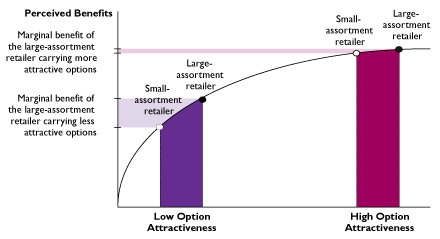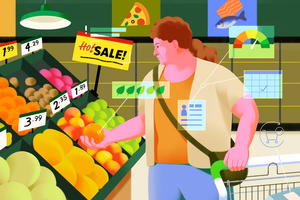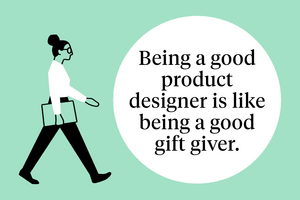Marketing Jun 1, 2010
Corralling Consumer Choice
Optimizing assortment size based on perceived attractiveness
Squeezed by declining sales and tight financing, retail marketers face a difficult dilemma about sizing their selection of merchandise. Large selections may provide a better chance that consumers will find a match with their preferences, which boosts sales potential. But offering smaller selections can reduce retailers’ costs—an especially tempting alternative in a budget-cutting environment. So the question arises: is more choice always better? Do consumers prefer a smaller assortment under certain conditions? With ever-increasing choices in categories ranging from TV channels to paint, is there a point at which too many choices can overwhelm a consumer and block decision making entirely?
In consumers’ decisions about selecting one retailer over another, the effect of assortment size is directly linked to the relative attractiveness of the options. Research conducted by Alexander Chernev, an associate professor of Marketing at the Kellogg School of Management, and Ryan Hamilton, an assistant professor at Emory University, indicates that consumers actually prefer a smaller assortment of items when the selection is considered more attractive than alternative options. Chernev and Hamilton’s study shows how choice and the relative attractiveness of selections interact to generate predictable outcomes in consumer behavior.
“Consumers don’t always want more choices. Sometimes a larger selection can lead to less satisfaction or even not choosing at all,” Chernev says. For example, people who are considering investing in mutual funds may ultimately keep their money in cash because they cannot decide which mutual fund best fits their needs. Many retailers recognize this repercussion and trim their assortment choices to make decisions easier. However, offering a smaller selection can cut into sales volume by not appealing to enough consumers. So, optimizing the assortment size is a very real challenge. “One of the factors that is overlooked is the composition of the assortment and the tools we have to define ‘attractiveness.’ When will a large assortment or a small assortment be better?” Chernev asks.
Preference for Assortment Size Interacts with “Option Attractiveness”
Chernev and Hamilton’s research studies how consumers weigh the relative attractiveness of the assortment in making decisions about whether they prefer a large or small assortment. They found some surprising results: with a “more attractive” selection, consumers prefer a smaller assortment of items; in a “less attractive” selection situation, buyers preferred a larger assortment.
Chernev and Hamilton say that increasing the attractiveness of the options in both larger and smaller assortments is likely to bring the assortments closer together in terms of the perceived consumer benefits (Figure 1). Faced with options that are less attractive, consumers see more benefits in a larger assortment. But when the options offered are very attractive, a smaller assortment appeals to buyers.

Figure 1: Perceived benefits as a function of assortment size and option attractiveness
Chernev and Hamilton conducted an experiment in which sixty participants ordered lunch from one of two sandwich shops; they had to choose either a menu with nine sandwiches or a menu with 38 sandwiches. One group of participants was told that both sandwich shops used premium ingredients for great-tasting sandwiches that rated 4.5 stars out of 5 on a taste scale. The other group of participants was told that both shops used only average ingredients and were rated 1.5 stars. The menus were sealed so that the participants could not preview the sandwich descriptions; they had to pick a menu based only on the number of sandwiches offered.
Participants who had to select from the high-quality shop preferred the smaller assortment to those at the low-quality shop. Among the group that was given menus from the higher-ranked shop, 40 percent preferred the smaller nine-item menu. In contrast, only 13.3 percent of the participants who had to choose from the lower-ranked shop wanted the smaller assortment of nine sandwiches.
Chernev points out that “option attractiveness” in the real world can also mean the perceived quality of a manufacturer or the retailer’s image, as well as quantifiable rankings of quality, such as the star-ratings of the sandwich shops in the experiment.
In their next experiment, Chernev and Hamilton used more diverse products and found even stronger preference for the small-assortment/high-attractiveness option. Using three different product categories—data CDs, dating services, and vitamin water—244 participants were asked to imagine that they had to select one of two retailers from which to purchase the product. In each case, the choice was between a high-quality retailer and a low-quality retailer. For the data CDs, the stores had one-star or five-star rankings; the dating services used either one or twenty matching characteristics; for the vitamin water, the stores had either the most popular brands or only low-priced economy brands. Each seller presented a different assortment size: six brands or nine brands of data CDs, eight potential matches or 24 potential matches from the dating services, and eight brands or 30 brands carried by the vitamin water stores.
In all product-choice groups, the same pattern appeared as before. Respondents preferred larger assortments from the low-quality sellers and smaller assortments from the higher-quality sellers. Of the data CD buyers, 55.3 percent of the participants chose the smaller assortment when the perceived quality of the store was high; only 32.3 percent took the smaller assortment from the lower-quality store. In the dating services scenario, 62.5 percent of the participants went for the smaller assortment from the higher-quality service, while 22.2 percent preferred the smaller assortment from lower-quality service. Among the vitamin water choices, the smaller assortment was preferred by 64.6 percent of the participants who selected from the store with more-popular brands, compared to 35.4 percent who wanted a smaller assortment from the economy-brand store.
Developing Retail Strategies Based on Assortment-Size Research
Chernev and Hamilton point out that their research offers real-life implications for retailers—not only to adjust overall assortment size but to fine-tune specific product lines or merchandise offered at different locations. Using strategies based on the research, retailers can reduce inventory and optimize shelf space. But the real value in the assortment size research helps answer a core marketing question, notes Chernev: “What is better from a consumer’s standpoint?”
Chernev, Alexander and Ryan Hamilton. 2009. Assortment size and option attractiveness in consumer choice among retailers. Journal of Marketing Research 46:410-420.


